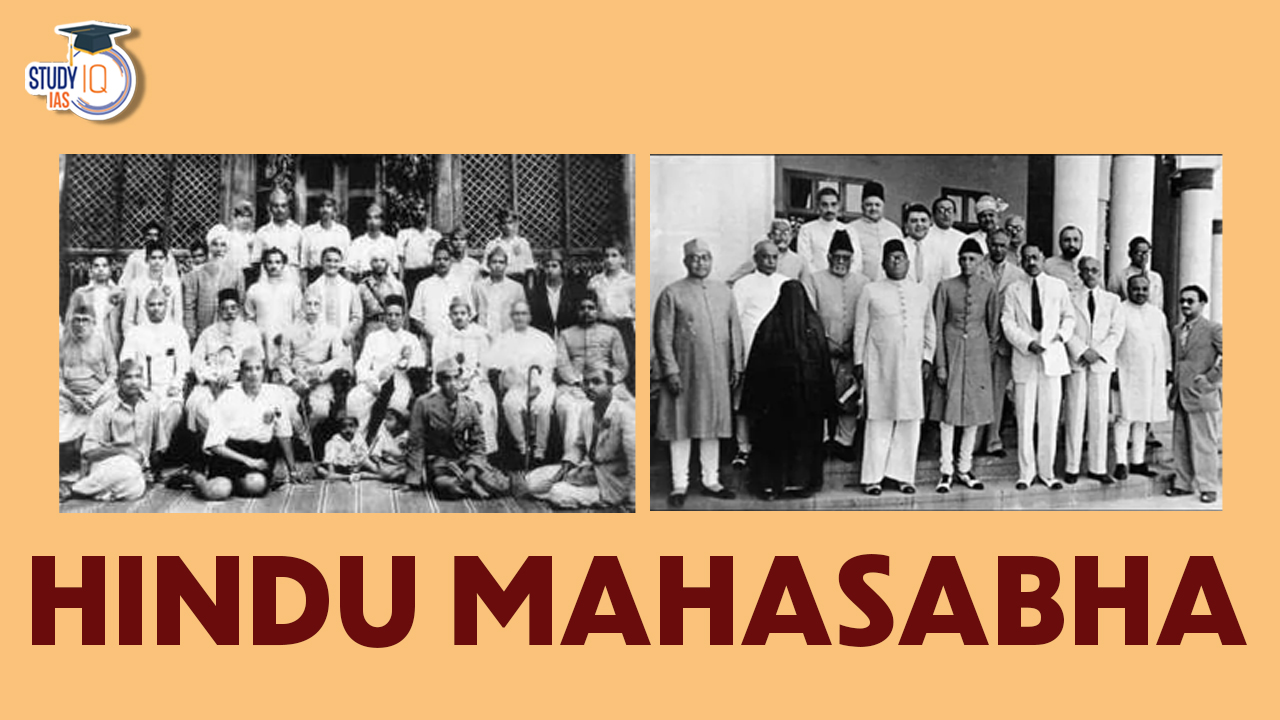Table of Contents
Hindu Mahasabha
Hindu Mahasabha was established in 1915. The group was founded by Hindus who wanted India to be a Hindu nation. India should only be a Hindu nation, according to the Mahasabha. Any accommodations made to Muslims or other minorities were rejected.
Hindu Mahasabha History
India was then under British dominion. Numerous Indians desired independence from the British. India’s independence was fought for by the Indian National Congress. But after the British left, the Hindu Mahasabha desired a different India. In their opinion, Hindus ought to have more authority and rights in an independent India.
In 1915, the Mahasabha was established in Calcutta. As its first leader, Vinayak Damodar Savarkar was appointed. He favoured fewer rights for minorities and equality for Hindus. Lala Lajpat Rai and Madan Mohan Malaviya initially backed the Mahasabha as well. The Mahasabha opposed Gandhi’s proposal for Muslim-Hindu harmony. Muslims, in their opinion, could never be loyal to an independent India. They want a distinct division between Muslims and Hindus.
The Mahasabha initially opposed the Indian National Congress. The Congress wished for India to be a multireligious country. However, the Mahasabha solely desired a Hindu nation. Numerous Hindus quickly joined the Mahasabha. They believed that under the British, minorities had unique rights. Independent India should be ruled by Hindus. This message was disseminated by the Mahasabha throughout the independence movement.
When the Hindu Mahasabha first began, they saw India as a country exclusively for Hindus. It opposed Gandhi’s vision of Hindu-Muslim unity as well as concessions for minorities. Hindus should have more power and rights in an independent India, according to the Mahasabha. In the campaign for independence, it was split from Congress by its rigid position against minorities.
Hindu Mahasabha Policy
The Hindu Mahasabha held the view that Hindus owned India. It desired a Hindu-run India for Hindus. The Mahasabha’s fundamental philosophy was as follows. The Mahasabha disapproved of the notion that India is a land of many religions. It was opposed to Mahatma Gandhi and Congress’ secular outlook. The Mahasabha thought that under the British, minorities in India, particularly Muslims, had unique rights. Ultimately, India must become independent.
The Mahasabha favoured Hindus and aimed to increase their influence. Less representation and rights should be granted to minorities. The Mahasabha was against any type of preferential treatment for minorities in politics, employment, or education. The Mahasabha desired that Hindu culture and ideals be reflected in India’s laws and policies. It favoured imposing Hindu traditions on all citizens. The Mahasabha believed that India was an old Hindu nation rather than a multireligious and multicultural one.
The Mahasabha was against the idea of combined electorates, in which all voters cast ballots jointly. In an independent India, it wanted religious groups to have their own electorates. In doing so, the Mahasabha intended to lower the representation of Muslims. The Mahasabha was likewise against British-sponsored reforms. These included the elimination of untouchability, the prohibition of child marriage, and the expansion of women’s rights. According to the Mahasabha, these Western concepts pose a threat to Hindu traditions.
The Mahasabha embraced capitalism in terms of economic policies. It was opposed to government intervention in the economy and socialist ideologies. According to the Mahasabha, Hindu businessmen are most impacted by government supervision. The Mahasabha sought strong restrictions on Muslim immigration to India in terms of foreign policy. Additionally, it sought to advance Hindu interests globally, notably in Pakistan and Bangladesh.
Hindu Mahasabha Leadership
A Hindu nationalist group in India was called the Hindu Mahasabha. They established it in order to safeguard and advance the interests of the Hindu community. The Hindu Mahasabha was moulded by numerous influential figures. Their direction modified its operations and policies. The Hindu Mahasabha was founded in 1915 by Madan Mohan Malaviya. He believed that for Hindus to occupy their proper place in society, they required a collective. First he led it. Under his leadership, the Hindu Mahasabha supported Hindu-important social and political concerns.
In 1921, Lala Lajpat Rai was elected president. He raised the bar for the company. He planned large gatherings and demonstrations to inform the public of the issues Hindus faced. In his opinion, Hindus ought to demand more justice. However, he sought demands by peaceful means. From 1937 to 1943, Vinayak Damodar Savarkar served as president. He introduced a more forceful concept to the group. He desired to establish a Hindu Rashtra, or Hindu country. He believed that Hinduism has always dominated India. He considered Christians and Muslims to be foreigners. Many leaders at the time disagreed with his views.
From 1945 until 1947, Dr. Shyama Prasad Mookerjee served as president. He was against the division of India. In 1949, he founded Bharatiya Jana Sangh after leaving the All India Hindu Mahasabha. Later on, it changed its name to Bharatiya Janata Party. He opposed Article 370, which grants Jammu and Kashmir a special status as a member of parliament. He passed away during a trip to Kashmir in a mysterious manner.
The president from 1931 to 1937 was B.S. Moonje. The Hindu community was brought together by him. He encouraged social reform in Hindu society. He founded the “Hindu Rashtra Dal,” the military wing of the Hindu Mahasabha. He increased awareness of ancient Indian history and culture. From 1957 until 1965, Deendayal Upadhyaya served as president. He discussed integral humanism, emphasising the interconnectedness of all life. He desired a nationality founded on Hindu principles of peace. He was against prejudice in Hindu society. He believed in giving the poor more power.
From 1946 until 1949, Sampurnanand served as president. He made an effort to enhance the company’s reputation. He spoke about intercommunity harmony during the Partition bloodshed. In his era, efforts were made to transform Hindu Mahasabha into a more diverse Hindu nationalist group. K.R. Malkani held the office of president from 1949 until 1969. He desired a nationalism that reflected the culture and spirit of the Indian people. He attempted to make Hindu Mahasabha more moderate.
In summary, Hindu Mahasabha’s leadership underwent significant shift over time. Early leaders emphasised claiming their Hindu identity more. Later leaders expanded the organization’s diversity and moderate viewpoints. Under several leaders, its work was influenced by various philosophies.
Hindu Mahasabha UPSC
Madan Mohan Malviya formed the Hindu Mahasabha in 1914.It collaborated with the Arya Samaj and other Hindu groups. It had a close connection to the Rashtriya Swam Sevak Sangh, which K.B. Hegewar started in Nagpur in 1925.In 1915; Hardwar hosted the first All India Hindu Mahasabha Conference. After 1929, the Sabha became more militant and began to spread Hindu Rashtra, which was completely different from Gandhi’s Ram Rajya.


 Jallianwala Bagh Massacre, Date, History...
Jallianwala Bagh Massacre, Date, History...
 NCERT Books for UPSC Preparation, Check ...
NCERT Books for UPSC Preparation, Check ...
 UPSC Syllabus 2025, Check UPSC CSE Sylla...
UPSC Syllabus 2025, Check UPSC CSE Sylla...





















